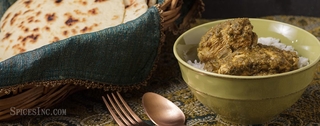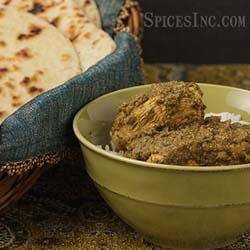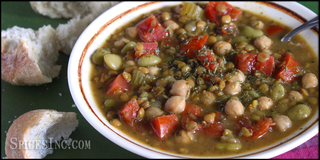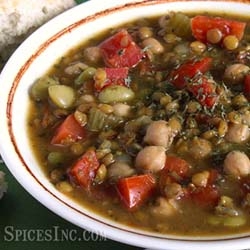Organic Ground Ginger
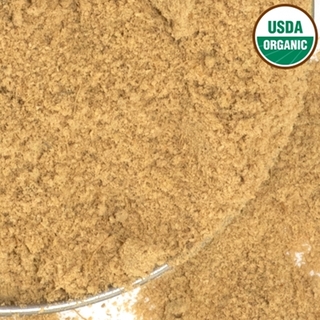
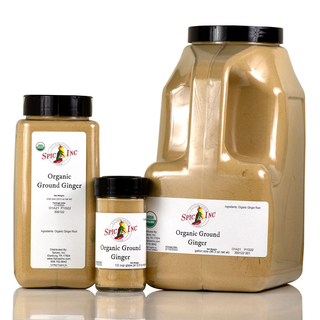


Organic Ground Ginger
Organic Ground Ginger, Zingiber officinale, is an herbaceous perennial that belongs to the family Zingiberaceae. Other members of this family include Turmeric, Cardamom and Galangal. Both Ginger and Turmeric are a rhizome which are thick underground stems that sprout roots underground and shoots above.
While some botanists believe ginger is native to China, others argue that it is indigenous to India (the greatest genetic diversity of this species has been found on the eastern coast of India). Ginger has subsequently been cultivated in Southeastern Asia, Africa, Jamaica, India and Australia.
Ginger has 1% to 4% essential oil, depending on the variety. The essential oil is mainly comprised of sesquiterpenes, which gives the ginger its characteristic scent, but not its bite.
Ginger is called zanjabil in Arabic, gan jiang in Mandarin, gingembre in French, ingefer in German, sauth in Hindi, shoga in Japanese, gengibre in Portuguese, imibir in Russian, and jengibre in Spanish. East Indian Pepper or Ginger Powder are other names for ground ginger.
History of Ginger
Ginger is from the 14th century Old English gingifer which comes from the Late Latin gingiber, derived from the Sanskrit singabera. Singabera means "shaped like a deer's antlers," which is a fitting description of ginger. It is one of the best known and oldest spices in the world. The Maharata, a Hindu text written around 4 BCE, recorded the use of ginger as an ingredient in stewed meat dishes. Other references to ginger appeared in the writings of Confucius (551-470 BC) and also in the Holy Qur'an (609-632 AD) where it is said to be one of the fruits found in heaven which await the righteous: "And they will be given to drink there of a cup (of wine) mixed with zanjabil". (Q. 76:17) Zanjabil is the Arabic word for Ginger.
Ginger's use in China and India dates back to ancient times, and in the 1st century AD traders introduced ginger to the Mediterranean region. As one of the spices first traded along the Spice routes and Silk Road, ginger's value held strong. Discordes, a Greek military physician, and Pliny, a Roman naturalist, valued ginger's power to solve a variety of complaints relating to digestion. Ginger was used primarily as a medicine in ancient Rome and Greece, but by the late middle ages in Europe it had gained considerable traction as a sweet and an aphrodisiac. By the 11th century ginger was well known in England. The Spanish Conquistadors brought it to Mexico and the West Indies. By the mid 1500's demand for this spice reached such high levels that both the Portuguese and Spanish were cultivating it in the new tropical colonies and exporting back into Europe.
Ginger's popularity in America came with the colonists. Having been previously very popular in Europe, ginger's presence in the New World was inevitable. Of course, they would take their spices with them to their new home. It was easy to cultivate on the newly colonized land, and then they would have had plenty to grind up. Ground was the most popular of all the forms of ginger. Today, thanks to the increased interest in Asian style cooking, fresh ginger has become more widely available in the United States and more popular in general. Ground ginger retains its popularity as well.
The very first American cookbook had three different recipes for gingerbread; not only was the type suitable for cookies included, but the kind used in breads was also there. Gingerbread cookies were sometimes used in bargaining with potential voters for their votes in early America- politicians would try to secure the public's positive opinion of them with the decadent, snappy cookies.
Ginger is frequently used as a palate cleanser between dishes or types of sushi in Asian restaurants.
According to WebMD, Ginger contains chemicals that may reduce nausea and inflammation. Researchers believe the chemicals work principally in the intestines and stomach, but they may also influence the brain and nervous system to control nausea.
A review of 6 randomized, double-blind, controlled trials with more than 650 participants, published in the April 2005 issue of the journal, Obstetrics and Gynecology suggests that ginger is effective in reducing the severity of nausea and vomiting in pregnant women. This research also did not find any significant adverse side effects during the monitored pregnancies.
The November 2003 issue of Life Sciences published a study suggesting that ginger's beneficial inflammation effects can be traced to one of its active chemical compounds, 6-gingerol (a relative of capsaicin and piperine). In this test tube study, 6-gingerol was found to significantly inhibit the production of nitric oxide, a highly reactive nitrogen molecule that quickly forms a very damaging free radical called peroxynitrite. Peroxynitrite generation is a crucial pathogenic mechanism in conditions such as cancer, diabetes, chronic heart failure, chronic inflammatory diseases, myocardial infarction, neurodegenerative disorders, circulatory shock and stroke.
Ginger Cultivation
Ginger's leafy stems grow more than 3 feet high with 6"-12" leaves. Ginger sprouts flowers that are in dense cone shaped spikes about 2"-3" long and 1" thick.
Today, Ginger is almost never grown from seed and is instead propagated by planting rootstalk cuttings. To harvest, the ginger rhizomes are pulled from the soil, cleaned and then dried in the sun. The dried ginger rhizomes are irregular in shape, branched or palmate (having a shape similar to that of a hand with the fingers extended). The color varies from pale yellow brown to light brown to dark yellow. Ginger may be unpeeled (leaving the outer layer), partially peeled, or completely peeled (removing the outer skin and the thinner inner skin).
The flavor and quality of dried ginger varies greatly depending on where it is cultivated. Jamaican ginger that is peeled is considered by ginger coinsurers as being the finest available. Ginger from Jamaica has a pale color, subtle aroma and very fine textured powder, it's also the most expensive and very difficult to find, as practically all the rhizomes grown on the island are consumed there. African grown ginger tends to be unpeeled and harsh, while Australian cultivated ginger has the strongest lemony undertones of all the gingers.
Depending on the time of year, our Ginger is sourced from India, China, Jamaica or Nigeria.
Cooking with Ginger
Ground Ginger is a staple in bakers' pantries and is frequently used in combination with ingredients with strong flavors such as molasses.
In the Middle East, ginger is used to season couscous, tangines and slow-cooked meat dishes made with fruit. Ginger plays a key role in Indian dishes, and is a signature ingredient in Chinese, Japanese, Korean and Vietnamese cuisines for flavoring meat, seafood and vegetarian dishes. In this country, ginger is probably most recognized as a baking spice in cakes and cookies.
It is best to add Ground Ginger when the dish is almost finished cooking as it is easy to overcook which causes the flavor to quickly dissipate. If you are making something that is quite dry, dissolve the ginger powder in warm water or another warm liquid so that it can be evenly distributed in the dish.
Pickled ginger is common in Japanese cuisine to clear the mouth of flavor between dishes, and is also eaten as a snack. In India and Sri Lanka, both dried and fresh gingers are frequently consumed. Dried, it is found in curry blends and snacks, stir frys, or desserts. Indian vegetarians love to use this spice to give a lot of flavor to many of their dishes.
Ginger pairs nicely with carrots, pumpkin, winter squashes and sweet potatoes. Ginger also blends exceptionally well with fruits such as bananas, pears, pineapples and oranges.
Ginger flourishes when used in combination with cardamom, cinnamon, cloves, dried fruits, honey, nutmeg, nuts, preserved lemons, paprika, pepper and saffron.
Some of the our more popular recipes with ground ginger are Punjabi Chicken with Tomatoes and Spinach, Sichuan Pepper and Beef Stir Fry, Ginger Spiced Grilled Pork Chops, and Moroccan Soup.
We also carry Crystallized Ginger (also known as Candied Ginger or Glace Ginger) and a conventional Ginger Powder, or ground ginger.
While fresh ginger tends to be much less expensive than ground ginger, you don't need near as much ground ginger in recipes and ground ginger lasts much longer than fresh.
What Does Ginger Taste Like?
Ground Organic Ginger is peppery and warm with lemon undertones. You'll also notice a slightly fiery taste with a pungent aroma.
Substitutions and Conversions
Ginger can be replaced with ground allspice, ground cinnamon, ground mace, or ground nutmeg if it is not immediately on hand.
Fresh ginger is often less expensive than ground ginger, but the benefit of having ground ginger is that has a much longer shelf-life. You also need much less ground ginger in recipes than you would if you were using fresh ginger. 1 tablespoon of fresh ginger is roughly equal to 1/8 teaspoon of ground ginger.
Since they have two very distinct flavor profiles, we do not recommend substituting fresh ginger in any recipe that calls for ground ginger, or using ground ginger for any recipe that calls for fresh ginger.
Read More
The Best Fruit and Vegetable Seasonings
Holiday Spice Guide
Flavor Characteristics of Spices
Smart Sugar and Salt Substitutes
Nutrition Facts
Serving Size1 tsp
Amount Per Serving
Calories9
% Daily Value*
Total Fat0g0%
Saturated Fat0g0%
Trans Fat0g
Polyunsaturated Fat0g
Monounsaturated Fat0g
Cholesterol0mg0%
Sodium0.6mg0%
Total Carbohydrate1.9g1%
Dietary Fiber0.4g1%
Total Sugars0.1g
Added Sugars0g0%
Sugar Alcohol0.0g
Protein0.2g0%
Vitamin D0mcg0%
Calcium3mg0%
Iron1mg3%
Potassium34mg1%
*The % Daily Value (DV) tells you how much a nutrient in a serving of food contributes to a daily diet. 2,000 calories a day is used for general nutrition advice. These values were calculated and therefore are approximate. For more accuracy, testing is advised.

